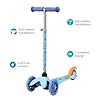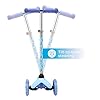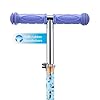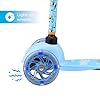Campior Red Mini 3 Wheel Scooter for Kids – Lean-to-Steer with LED Light-Up Wheels, Adjustable Handlebar, Wide Anti-Slip Deck, Smooth PU Wheels, Rear Foot Brake – Toddler Scooter for Ages 2+
$32.99 (as of July 8, 2025 17:32 GMT +00:00 - More infoProduct prices and availability are accurate as of the date/time indicated and are subject to change. Any price and availability information displayed on [relevant Amazon Site(s), as applicable] at the time of purchase will apply to the purchase of this product.)Hoverboards and electric scooters are both exciting personal electric vehicles that are gaining popularity for recreational riding and green commuting. But which one is better? This in-depth comparison of hoverboards versus e-scooters will help you decide which electric ride is right for you.
Overview Comparison
Here is a quick overview comparison of hoverboards versus electric scooters:
| Feature | Hoverboard | Electric Scooter |
|---|---|---|
| Wheels | Two side-by-side wheels | Two or three inline wheels |
| Foot Position | Feet side-by-side like a skateboard | Feet forward like on a scooter |
| Steering | Lean body to turn | Handlebars to turn |
| Braking | Foot pads | Hand brake + foot brake |
| Range | Up to 12 miles | Up to 40 miles |
| Speed | Up to 10 mph | Up to 20 mph |
| Terrain | Smooth, flat surfaces | Variety of surfaces |
| Portability | Very portable | Foldable but bulkier |
| Price | $100-$500 | $200-$2000 |
As you can see, electric scooters tend to have advantages in terms of speed, range, and terrain versatility. However, hoverboards are more portable and less expensive. Keep reading for a more detailed comparison!
Power and Speed
Hoverboards

Hover-1 Ultra Electric Self-Balancing Hoverboard Scooter
The Hover-1 Ultra Hoverboard is an exciting and innovative self-balancing scooter that promises a thrilling and convenient mode of transportation. With its sleek design, powerful motor, and impressive features, this hoverboard offers an unforgettable riding experience for enthusiasts of all ages.
Key Features
- Hoverboards have electric motors of around 300-700 watts and reach speeds of 6-10 mph typically. This is a jogging pace suitable for recreation, not transportation.
- Electric scooters have more powerful motors from 350-1000 watts. The best models can reach 15-20 mph, a bike commuting speed. Some high-end electric scooters boast up to 27 mph top speeds.
- E-scooters are faster and better for covering longer distances quickly. Their extra speed makes them more functional for commuting or running errands.
Electric Scooter

6. Razor E200 Electric Folding Scooter
The easy-to-ride, easy to use E200 electric scooter is one that fits any commuter! It is made with top notch quality materials which make it durable and offers a free and comfortable ride for its users.
It features a rear braking system, fair enough for its’ speed limit. The deck and frame is big enough to size large people.
The E200 machine is powered with 200 W, chain driven motor, has a high torque and single speed. With these qualities it is safe to say that this electric scooter isn’t just designed for adults but for bigger weight individuals. This makes it part of the best electric scooters.
Range
- Hoverboards max out at 7-12 miles per charge typically. Their small wheels and weak motors limit their range. This is fine for neighborhood use but not long trips.
- Good electric scooters can easily hit 15-30 mile ranges thanks to their larger batteries and efficient motors. Some high-end electric scooters can even exceed 40 miles per charge.
- For going the distance, electric scooters are easily the better choice for range. You can commute, run errands around town, or joyride for hours before recharging.
Riding Experience
- Hoverboards have a unique riding experience akin to snowboarding or skating. You cruise by shifting your body weight and leaning. This takes practice but is fun!
- Electric scooters feel more familiar with handlebars for steering. Just hop on, twist the throttle with a wrist flick, and go. No learning curve required.
- Electric scooters provide a more intuitive and beginner-friendly riding experience. Hoverboards offer a more challenging but playful experience once mastered.
Terrain Handling
- Hoverboards rely on their small wheels and limited clearance to only handle smooth, flat pavement and indoor floors. No bumps or cracks.
- Electric scooters come with larger air-filled tires and some ground clearance, allowing them to absorb bumps and handle rougher terrain.
- For riding anywhere and everywhere, electric scooters can tackle more terrain types comfortably. Hoverboards require near-perfect conditions.
Portability
- Hoverboards weigh around 15-30 pounds. Their compact shape and one-piece design makes them easy to carry or stow away.
- Electric scooters weigh 25-40 pounds typically. Foldable designs help but they still tend to be bulkier and trickier to transport than hoverboards.
- If easy portability is key, hoverboards win for their lightweight simplicity. They’re effortless to carry into stores, classes, etc.
Safety

- Hoverboard riders are at higher risk of falls and collisions without shock absorption and inability to brake suddenly. Protective gear is a must.
- Electric scooters have better stability with inline wheels, suspension, and hand brakes for sudden stops. But care is still required at high speeds.
- For new riders, especially kids, electric scooters offer a little more safety thanks to their brakes and stability. But neither is foolproof.
Cost and Value
- Hoverboards range from $100 for low-end models to $500 for premium brands with better batteries, motors and features.
- Electric scooters have a very wide price range from $200 to $2000+. Budget models exist but many good commuter scooters are $600-$1000.
- With overlapping prices, hoverboards offer better value for the money in terms of “fun per dollar”. But serious transportation has higher e-scooter costs.
Riding Areas
- Hoverboards are best suited to smooth paths, indoors spaces, empty parking lots, etc. Their small wheels can’t handle rough roads.
- Electric scooters are street legal in many areas and rugged enough to handle urban terrain like sidewalks or bike lanes. Some can even go off-road.
- For accessing more public spaces legally, electric scooters open up many more riding areas. Hoverboards are limited to private property.
Maneuverability
- Hoverboards are incredibly nimble, with riders able to spin and drift within their own footprint. Great low-speed control once mastered.
- Electric scooters have slightly wider turns but still offer excellent maneuverability around obstacles and tight spaces.
- At low speeds, hoverboards edge out e-scooters for agility and tricks but both are impressively maneuverable on city streets or pathways.
In Summary:
| Feature | Better Suited For |
|---|---|
| Speed and Power | Electric Scooters |
| Range | Electric Scooters |
| Beginner Friendly | Electric Scooters |
| Terrain Handling | Electric Scooters |
| Portability | Hoverboards |
| Safety | Electric Scooters |
| Affordability | Hoverboards |
| Access to Public Spaces | Electric Scooters |
| Maneuverability | Tie |
So in choosing between hoverboards versus electric scooters, consider your priorities in terms of speed, range, terrain, budget, safety and riding style. Both can be incredibly fun! But electric scooters are more practical transportation while hoverboards bring out your fun inner-child. Decide which ride matches your needs and enjoy!

I’m the founder of HoverboardsGuide.com, a comprehensive website dedicated to electric scooters and hoverboards. With a deep-rooted passion for electric gadgets, I’ve accumulated extensive experience in this field. I aim to assist users in selecting the best gadgets and providing reliable guidance.
I’ve tested and reviewed numerous models, gaining in-depth knowledge about their features, performance, and overall quality. Feel free to reach out to me with any queries, as I’m dedicated to addressing your concerns promptly. Join me on this exciting journey of exploring the world of electric rides and making informed decisions













